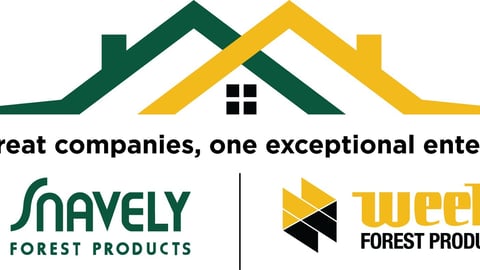How Snavely and Weekes are building an ‘exceptional enterprise’
Snavely Forest Products and Weekes Forest Products, founded in 1902 and 1978 respectively, are both revered names in the world of building materials. Both are now subsidiaries of the MacArthur family of companies, meaning they are on the same team but rowing their own boats—albeit in the same ultimate direction. It’s all part of their “Two great companies, one exceptional enterprise” motto, which speaks to the close collaboration that makes Snavely and Weekes unique.
HBSDealer spoke with Clark Spitzer, president of Snavely Forest Products, and Scott Gardner, who serves as president of Weekes Forest Products, to learn more about how the companies complement, sharpen and enhance one another—while maintaining autonomy and distinct identities.
Q: Can you share a bit about your companies’ culture and how you operate?
Spitzer: Both of our companies were acquired by a larger company to develop a two-step platform <”One-step,” in this case, refers to selling direct to the end user; “two-step” is selling to retailers.>
The way our culture runs, employees act like owners. We’re an ESOP (employee stock ownership company), which lends itself to more accountability, buy-in and genuine care and concern. The cool thing is the way this organization runs, we’re two different companies. We were acquired as two really good companies.
Gardner: We really are building two great companies and one exceptional enterprise. We possess two distinct cultures. We’re both independent businesses. We’re also looking internally and externally how to maximize national accounts efforts. It’s a combined effort rather than a merger, which is pretty unique in our industry.
In terms of collaboration and navigating change, we’re building the bike as we ride it.
Q: What trends are you seeing in the business and industry, and what trends will be crucial moving forward?
Spitzer: Consolidation—and all the changes that brings about. The needs change as the industry changes.
Twenty years ago, the big-box retailers had a large impact on the cash-and-carry business, and the independent lumberyards pivoted to include more of the contractor business. But now that’s even changing. The needs of the channel continue to evolve, so we’re evolving too.
Part of our business is constantly adjusting to the needs of the market. For instance, customers are looking to us to act more globally, and we’re responding. Our manufacturers depend on us to grow market share, and dealers want help in growing sales. We have to be more and do more than buying and holding inventory.
As we continue with our acquisition strategy, we will only consider companies that are well managed and operated. Making smart, strategic acquisitions is about being selective. We do not alter the cultures or reputations of companies that become part of our enterprise, which ensures their unique identities are preserved.
Gardner: Our two-step customers, and also suppliers, are continuing to consolidate. The challenge for us, is, how do we sell to our customer base, which are fewer in number but bigger in size?
Two-step wholesale consolidation will also become more prominent moving forward. That means fewer acquisition targets.
So, how do we add value to this chain? We have to offer more than just storage and logistics. We have to become more than an inventory outlet. To respond, we’re leveraging more technology and marketing support and offering more personalized service. We’re working hard to elevate our partner vendors’ brands.
For Weekes, one of our biggest differentiators is our product mix. Weekes has significant work on the commodity side of the business <e.g. 2x4s, OSB panels>. We also have a separate Industrial division <e.g. construction and utility poles, access crane mats, etc.) It’s all about finding niches where you can meet specific needs and building meaningful relationships.
Q: What technologies are important for you right now?
Spitzer: Snavely is very tech driven. I’d say we’re “leading edge,” not “bleeding edge.” We use a warehouse management system, which is a bolt-on system from our online warehouse management system and pairs with our ERP platform, which builds discipline into distribution. It helps us report real-time inventories and connects salespeople to inventory no matter where they are, including visibility on a mobile app.
Technology significantly enhances the efficiency and effectiveness of two-step distribution in several ways: inventory management, automated processes, pricing models, advanced shipping notices and quoting. We are thoughtful and strategic about our investments in technology, as our industry is on a different adoption timeline than other industries.
We have an online division, which focuses on making our products available in the digital world to the online retailer. For many existing customers it is an extension of their businesses, which can connect them to the omnichannel. Customer portals that offer self service account and order management, support requests and a variety of additional resources are some of the features that enhance the customer experience.
In addition, we are maximizing digitally based marketing tools like email platforms, social media, digital campaigns, video, QR codes and a centralized digital asset repository - all which help us tailor messages to customers.
Q: Communication-wise, how do you maximize the “Two Great Companies, One Exceptional Enterprise” concept?
Spitzer: We print regular newsletters, which are mailed to employees’ homes to involve families. We produce an “On Deck” video, a simple podcast interview, that communicates company updates. Both companies conduct an employee engagement survey, conducted by a third party, to gather raw feedback from employees to see how we can improve. We had an 82 percent participation rate in the most recent iteration of the survey. Giving employees a voice is crucial, as it helps the company identify strengths and areas of improvement.
Gardner: We communicate often internally. We like face-to-face interaction as much as possible. We do quarterly newsletters that go to both companies. We visit each branch at least on a quarterly basis. We conduct town hall meetings to give company updates and to provide a forum for employee Q&A.
All employees are shareholders and owners, so it’s easy for us to have open book management and transparency. As an employee-owned company, our environment is more conducive to collaborative communication.
I recently had a truck driver employee who retired. He came to meet me along with his wife, and they both had tears in their eyes with gratitude thinking about all they’d been able to achieve because of this ownership culture we have.
Q: How can LBM industry leaders improve at employee engagement, retention and outreach?
Spitzer: Open, transparent communication is crucial. Retention’s actually not a big issue for us. I firmly believe employees are satisfied if they are treated with respect. By upholding this principle, we are able to create a more attractive and supportive environment that encourages employees to stay long-term.
The challenge now is: How do you get good people into the business? We’re recruiting all the time to find those right people.
Recruiting and employee development is something we take seriously. One of the unique things we do is offer a Leadership Development Institute program, a 15-month course for eight to 10 folks who want to sharpen more specific skills and essentially identify the next generation of company leaders. We employ a third-party company to conduct this customized program.
Those who enter the program meet virtually once per month with their executive coaches and complete coursework. We’ve seen those who participate develop a tight bond, even across the two companies.
We also provide educational and practical training modules like “What do you want to be when you grow up, and how can we help you get there?” Through this program, we’ve seen material handlers become salespeople and salespeople become execs.
We always say, there’s only one thing that’ll hold you back at this company: you. We don’t manage employees for the success of the business, we manage the business for the success of the employees.
Gardner: Our safety culture has also helped recruiting. We lead with safety. It’s our No. 1 non-negotiable to create a safe work environment.
Creating a welcoming physical environment is also crucial. You might not think much about things like having a big enough lunch room or a comfortable locker room, but these aspects of the company matter. Paying attention to these seemingly smaller details can make a big difference in employees’ lives.
Q: What's the vision for the company moving forward? And what changes, specifically, would you like to see occur in the LBM world?
Sptizer: As for changes, we pay close attention to market trends and where our companies can add value. I do think we strive for the Wayne Gretzky mentality of “Skating to where the puck is going to be, rather than where it is.” As a customer-intimate enterprise, we must know our customers and their customers well. This is how we will know how to adjust in the market.
In addition, we evaluate plenty of market drivers that lead us to ask several questions. Where’s all of this going? We see the big boxes getting into the contractor space, so what space is the lumberyard going to fill? Where is the big builder going? What are the needs in the channel that we can fill best?
We’re customer-intimate. We don’t innovate or make anything. So we have to go above and beyond in our efficiencies, relationships and processes. We have to know our vendors and their customers. If we do that right, we can adjust.
Gardner: Clark and I agree that as we delve into our combined strategy, we will blend our efforts from an internal and external perspective. We want to leverage our strengths, and to go-to-market as Weekes with the Weekes market and Snavely with Snavely’s market. We are an acquirer and will continue to acquire. Hopefully next time we talk, it’ll be “three or four companies and one exceptional enterprise.” We run our own businesses, but we help one another and work closely together. That makes us stronger.






